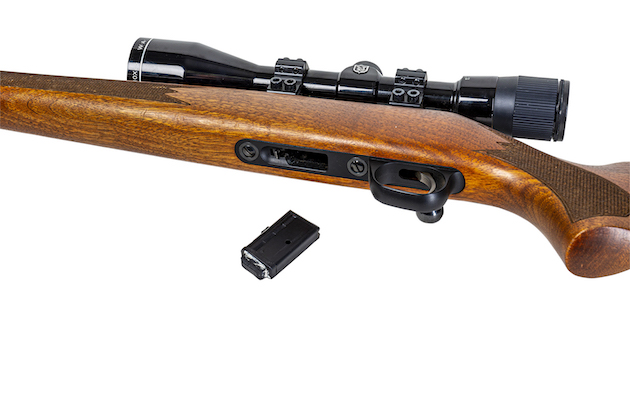The Sako Finnfire – worth every penny
Attractive and offering high build quality, this would make a great first or spare gun, says Charles Smith Jones

Sako decided in the 1990s that it was time to replace the Finnscout, a popular .22 rimfire that dated back to 1972. The new rifle was deliberately fashioned as a miniature version of Sako’s full-bore rifles but it differed radically from the Finnscout. Design apart, some metal assemblies, including trigger-guards and magazines, were replaced by modern plastics, which not only enabled more economical manufacture but ensured greater resistance to corrosion. Otherwise, there was no compromise in the components used or the build quality, and the resulting rifle quickly came to be appreciated as a premium gun and one of the best available in its class. Sako christened it the Finnfire.
Sako Finnfire 2 in .17 HMR
The Finnfire 2, as the name suggests, is a reincarnation of the famed Sako Finnfire rimfire from the 1990s. The Sako Quad, with…
Sako Quad Hunter .22LR rifle review
Sako Quad Hunter .22LR rifle review: The versatile Sako Quad Hunter is an impressive one-gun rifle system.
Sako M591
Sako was formally established during the 1930s and in 1983 it merged with Tikkakoski, another Finnish manufacturer, owners of the…
The Finnfire was produced in three variations. The original Hunter weighed just 5lb 11oz, had a slender profile and a 22in barrel. It proved to be an ideal gun for pest controllers. The Varmint model that followed it had a heavier 24in barrel and a slightly chunkier stock with beavertail fore-end. The Range was intended for target shooters with a free-floating, match-grade barrel and an ergonomic stock with adjustable butt plate and cheekpiece. Of the three, the Varmint eventually proved to be the most popular and is the one most likely to be encountered; the Range is probably the least often seen.

Quality walnut with chequering at pistol grip and fore-end
Sako decided in 2014 to resurrect the Finnfire as the Finnfire II, with upgraded features and a more modern styling. It is a rather different rifle to its predecessor.
It came only in a Sporter version and, in addition to the .22LR chambering of the original, was also available in .17HMR with synthetic stock and shorter barrel options. The Finnfire II remains in production today.

Sako Finnfire
Sights and trigger
The Hunter came with iron sights, while both the Varmint and the Range were supplied without, anticipating that the owner would wish to fit a telescopic sight or match sights of their own choice. The open sights are basic but functional with a post bead and are adjustable for windage. An 11mm integral dovetail allows for scope mounting.
The single-stage trigger is superb. It is the same unit fitted to Sako’s TRG-S centrefire rifles, breaks cleanly and is adjustable in all models to between one and two kilograms of pull. A single-set trigger was also available as an optional extra. With an opening angle of only 50 degrees and a throw of 30mm, bolt operation is swift and positive. The sliding safety catch is located to the rear of the bolt handle and locks both the trigger and the bolt.

The detachable magazine came with a five-round capacity
Barrels
Barrels are cold hammer-forged with a 1:16½in twist. These rifles are renowned for their accuracy and should be quite capable of producing exceptional results with the right ammunition. Only towards the end of production did any Finnfires leave the factory pre-cut to accept a moderator, usually with a ½in x 20 UNF thread. Many guns were subsequently customised by their owners and it is not uncommon to find shorter barrels and unusual stocks fitted.

Bolt operation is swift and positive
On all original Finnfire models the stock was of good-quality walnut with an oil finish and generous and attractive chequering at the pistol grip and fore-end. Matt lacquered stocks were available to order, but synthetic options only made an appearance with the updated Finnfire II. The detachable magazine is straight feeding and came with a five-round capacity, with a 10-round option available. Spares are readily sourced.
This rifle really can be described as a bit of a classic. As Sako rifles tend to hold their value well, the price of used examples may not be as low as some others, but this is a quality gun and the cost will probably reflect it. Not all bargains can be measured by price alone, though, so if you have the chance to lay your hands on one you would do well to give it serious thought and be prepared to pay a little more. It could be to your gain.

Only later Finnfires were pre-cut to accept a sound moderator
Tech specs for the Sako Finnfire
- Country of origin Finland
- In production 1994–2005 (Finnfire II since 2014)
- Action Bolt
- Stock options Walnut
- Barrel length 22in to 24in
- Magazine Detachable, five or 10 rounds
- Left-hand version No
- Weight (bare) 5lb 11oz (Hunter); 7lb 4oz (Varmint); 7lb 8oz (Range)
- Available in calibres .22LR (Finnfire II also in .17HMR)
- Cost new £725 (Finnfire II, synthetic stock)
- Cost used From around £400 for a good example, though often much more depending on version and condition
Verdict
This reliable little rimfire may not come cheap, but it is worth every penny











